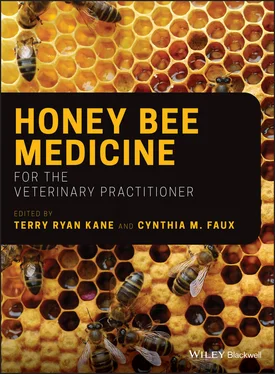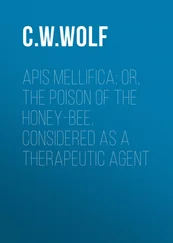A Critical Distinction: Vertical vs. Horizontal Disease Transmission
The method by which a disease is transmitted from colony to colony is a fundamental determinant of pathogen virulence. Vertical transmission (the spread of disease from parent to offspring) favors the evolution of avirulence whereas horizontal transmission (the spread of disease among unrelated individuals) favors the evolution of virulence (Lipstich et al. 1996). This is because pathogens and parasites that spread vertically need their host to stay healthy to produce offspring, whereas those that spread horizontally do not have this need. Although numerous other host factors (i.e. host longevity, density, population structure, and novel hosts) and pathogen factors (i.e. vector availability and pathogen replication potential) also influence virulence, we will focus on how the mode of honey bee pathogen and parasite transmission within and among colonies impacts the evolution of the virulence of these agents of disease.
Vertical Transmission: Swarming
In honey bees, one way that a colony achieves reproductive success is by swarming: an established colony casts a swarm to produce a new colony. The other way that a colony achieves reproductive success is by producing drones; even though weak colonies can propagate their genes by producing drones, this does not create another colony. If a pathogen or parasite that is transmitted vertically (from parent to offspring) weakens its host and so hampers it from producing offspring (which for honey bee colonies equates to casting swarms) then it reduces its own reproductive success. In short, the natural mode of colony reproduction in honey bees favors the evolution of avirulence in most of its pathogens and parasites. The two exceptions to this generalization are American foulbrood and Varroa destructor , both of which are easily transmitted horizontally when one colony robs honey from another.
Swarming also helps inhibit the reproduction of Varroa mites (and other agents of brood diseases) by creating a natural break in brood production, which forces the mites to likewise suspend their reproduction (Seeley 2017b). Once a daughter queen emerges to replace the mother queen that has left in a swarm, this daughter queen must leave the hive to fly to a drone congregation area, where she will mate with multiple drones before returning to the hive to commence egg laying. This transition from mother queen to daughter queen creates a period without sealed brood (needed for mite reproduction) that can last from 7 to 14 days. This imposes a break in the reproduction of the Varroa mites. Furthermore, with each swarming event a sizable fraction (approximately a third) of the colony's mite population is exported with the departing workforce: the fraction of mites shed can be readily calculated since about half of the female breeding‐age mites are on the workers in a colony at any given time, and nearly three‐quarters of these workers depart in the prime swarm (Rangel and Seeley 2012). In a six‐year study of the life‐histories of wild honey bee colonies living in a forest in the northeast US, Seeley (2017b) found that most (~87%) swarmed each summer.
In contrast to the relatively small nest cavities of wild honey bee colonies, the colonies kept by beekeepers occupy large hives, and they are less apt to produce swarms (Oliver 2015). The swarm control methods of beekeepers include transferring sealed brood to the top of the hive and queen exclusion (the Demaree method), cutting out queen cells, preventing the filling of cells around the brood nest with nectar (possibly a cue for swarming) by providing empty combs above the brood nest, reversing the brood boxes and inserting empty combs in the brood nest, and reducing the worker populations of colonies by splitting them. All of these methods weaken the stimuli that trigger swarming, but only one helps control the Varroa mites: the removal of bees. We propose instead controlled colony fission by making “splits” to mimic the beneficial effects of swarming on mite control (Loftus et al. 2016).
Horizontal Transmission: Bee Drift, Robbing, Forager Contact, and Contamination
Fries and Camazine (2001) outline three distinct things that a pathogen must do to reproduce and disperse to a new honey bee colony. A pathogen must: (i) infect a single honey bee; (ii) infect multiple honey bees; and (iii) infect another colony. Of these, it is the spread to another colony that should most concern beekeepers and bee doctors:
In terms of fitness, the successful transfer of a pathogen's offspring to a new colony is a critical step in its life history. If a parasite or pathogen fails to achieve a foothold in another host colony, the parasite will not increase its reproductive fitness, regardless of how prolific it has been within the original host colony. Thus, hurdles #1 and #2 (intra‐individual and intra‐colony transmission) are important aspects of pathogen fitness only to the extent that they contribute to more efficient inter‐colony transmission
(Fries and Camazine 2001).
The transfer of pathogens or parasites from one colony to another horizontally can occur by four main routes: drifting, robbing, contact while foraging, and shared use of a contaminated environment. Drifting occurs when a forager enters another colony by accident, something that is largely a byproduct of modern apiary management since the wide spacing of wild colonies largely precludes drifting (Seeley 2017b; Seeley and Smith 2015). Robbing occurs primarily during periods of a nectar dearth, when strong colonies attempt rob honey from weak ones. In this case, pathogen transfer is most likely to occur from the weak colony to the strong colony, though the opposite is also possible. The transfer of pathogens during contact while foraging has been described in both natural and experimental models, including video documentation of a Varroa mite jumping onto a foraging honey bee the instant the bee lands on a flower (Peck et al. 2016). Finally, diseases can be spread from one colony to another through sharing of contaminated water, as has been observed with infections of the microsporidium Nosema apis (L'Arrivée 1965).
Honey Bee Demographic Turnover
In the article entitled, What epidemiology can teach us about honey bee health management , Delaplane (2017) reviewed the ecological and evolutionary impacts of the host–parasite relationship and proposed that an important driver of virulence is the high rate of introduction of susceptible colonies into apiaries (i.e. the introduction of new individuals into existing populations). Epidemiologists recognize three distinct “compartments” for individuals in a population exposed to a disease: Susceptible (S), Infected (I), and Recovered (R) individuals. In the simplest SIR (Susceptible, Infected, and Recovered) model, once susceptible animals catch the disease they become members of the infected “compartment” and can spread the disease to susceptible individuals. The infected animals that survive then move into the recovered “compartment” and are considered immune for life (Kermack and McKendrick 1927). Delaplane argues that the beekeeping practice of restocking “dead‐out” hives with nucleus colonies prolongs the epidemic by introducing new “S” individuals into the population of colonies in an apiary, a process that fosters the evolution of virulence (Fries and Camazine 2001). In a closed population, however, a disease epidemic is not artificially prolonged and the surviving individuals tend to have resistance, so there tends to be coevolution of the host–parasite or host–pathogen relationship. Given the high levels of colony losses experienced by beekeepers each year, the restocking of colonies with “nuc” replacements – thereby introducing a fresh batch of susceptible individuals to the apiary population – may represent one of the most noteworthy (and easy to address) management practices contributing to the collapse of honey bee colonies (Cornman et al. 2012).
Читать дальше












